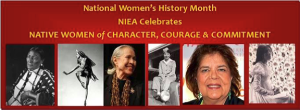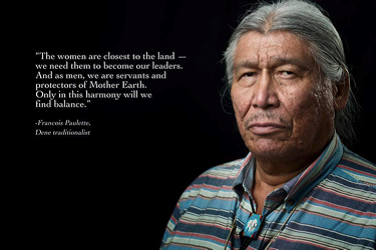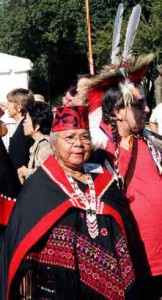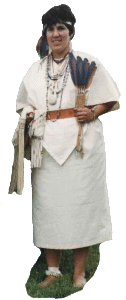There are articles on Native Women in History, Elder Meditations and other links and even a quiz on this page. 
You should find the following pages of interest: Woman’s Health Issues; Native Women in the Military; Violent Against Women Act; Shadow Wolves, The story of a Native Woman serving in U. S. Customs; Census Information; Health Issues; Socio-Political issues; Sara Winnemucca & Zitkaka Sha
“The honor of the people lies in the moccasin tracks of the woman. Walk the good road…. Be dutiful, respectful, gentle and modest my daughter… Be strong with the warm, strong heart of the earth. Be strong and sing the strength of the Great Powers within you, all around you.” –Village Wise Man, SIOUX
Women are the warriors our times call for……
Some people make the mistake of thinking women are only gatherers … gardeners … that they can only dig and pick and cultivate and hide. I tell you that women are the strongest, smartest and most dangerous hunters the world has ever seen. Individually, they may be physically overpowered, but in planning, in vision, in purpose and explosive action, they can’t be beat.Any honest man will admit there is nothing that fills them with awe so much as their partner when she has made up her mind. She has become an unstoppable, indomitable will. If it’s against him, he’d better start running!
There’s a narrative that women are weak, that they’re vulnerable, that they are somehow less intelligent or capable than a man. Well, they said that about serfs, about slaves, about people from other races. They say it about anyone they want to control. You see, it’s the storytellers that rule the world. And we repeat their stories.
It’s time for a new chapter.
It’s time to write a new reality. It’s time to stand up and tell your story. You are only vulnerable when you let others define you as vulnerable. You are only weak if you let them convince you it’s true. You are only ‘less than’ if you believe it. Women are warriors. They are the ones who run with wolves, the ones who follow the moon. They are the ones who give life and they are the first story tellers their children will hear.
Women have all the power of humanity. All the power to shape the world. Are you waiting for permission? Give it to yourself. Are you waiting for your time? It’s now. Are you waiting for a sign? Look around. You are the linch-pin, the tipping of the scales. The moment you say you’ve had enough. The moment you rise … Everything changes. We are in a battle for a future that our children, grandchildren and theirs can grow in, be safe in, be challenged in. Part of it means taking time for yourself, for silence, to breathe and renew. Part of it means to let go for a while. You’ve been carrying heavy burdens.
There will be men who cling desperately to the idea that they have power over you. Outsmart them. Outmaneuver them. Out plan and out-strategize. There are so many more good men willing to be your allies, willing to be your support, willing to be your partners. We are your sons, after all. We are in a battle for the soul of the planet. And you are that soul. You are the warriors. And this is your time. hiy hiy..-Aaron Paquette http://www.facebook.com/AaronPaquetteArt Aaron Paquette is a First Nations Metis artist, author and speaker. Based in Edmonton, Aberta, Canada. His Bestselling Novel ‘Lightfinder’ was published 2014 through Kegedonce Press and is now in 2nd printing.
ICYMI: President Obama Nominated the Very First Native American Woman For Federal Judge By Toyacoyah Brown on January 4, 2014
Diane J. Humetewa, a member of the Hopi tribe and former U.S. attorney in Arizona, has been nominated to serve on the U.S. District Court for the district of Arizona as a federal judge. If confirmed, she would be the first active member of a Native American reservation, and first Native American woman to serve as a federal judge. Not only would this bring more diversity to the federal bench, but Arizona’s prominent Native community will finally be represented in a state that is infamous for ignoring Native issues.
This is a big deal because she is a Native woman from the same Arizona that has become a police state through its insistence on criminalizing communities of color, deportations, and via renegade leaders like Sheriff Arpaio. Arizona is swiftly becoming a state known for its extreme racial profiling regarding folks who look “brown.” In Obama’s first term he nominated Arvo Mikkanen of the Kiowa Tribe, but Republicans blocked the nomination. Read more about the Humetewa nomination at PolicyMic.
 From the National Women’s History Museum
From the National Women’s History Museum
Ruth Muskrat Bronson, who was born October 3 in 1897, was a Native American rights activist. Her mother was an Irish American and her father was a Cherokee Indian. As a child, Muskrat Bronson saw firsthand the near dissolution of Cherokee Nation when Oklahoma was seeking and granted US statehood. She went on to serve for 12 years with the Bureau of Indian Affairs and penned the book, “Indians are People, Too .” Journal #2954 from sdc 10.4.13
 The Elders say the Native American women will lead the healing among the tribes. We need to especially pray for our women, and ask the Creator to bless them and give them strength. Inside them are the powers of love and strength given by the Moon and the Earth. When everyone else gives up, it is the women who sings the songs of strength. She is the backbone of the people. So, to our women we say, sing your songs of strength; pray for your special powers; keep our people strong; be respectful, gentle and modest. Oh, Great One, bless our women. Make them strong today. From: Journal #962 from sdc 11.05-11.9.97
The Elders say the Native American women will lead the healing among the tribes. We need to especially pray for our women, and ask the Creator to bless them and give them strength. Inside them are the powers of love and strength given by the Moon and the Earth. When everyone else gives up, it is the women who sings the songs of strength. She is the backbone of the people. So, to our women we say, sing your songs of strength; pray for your special powers; keep our people strong; be respectful, gentle and modest. Oh, Great One, bless our women. Make them strong today. From: Journal #962 from sdc 11.05-11.9.97
“…activist women….all over the world……speak of common purpose. They know what believe and they know what is real for them. Tribal teachings tell these women how their people came to be. It is those set of teachings, followed by subsequent cultural and spiritual guidance, that provides them with clear direction in life. These women recognize the relations among all living things and the responsibility to live in accordance with the natural laws given to us by the Creator. As women we understand this responsibility to care for our Mother Earth, because in caring for her we are caring for future generations and ourselves. Lori Lea Pourier
Take the NWHP Native American Women’s History Quiz!
There were somewhere between 7 and 11 million indigenous people living in what became the United States prior to European contact. These people belonged to hundreds of diverse nations and tribes. Their systems of government, their language, their economies, their social customs and their traditions were often extremely different from one another. This quiz presents information on women from a variety of nations and historical periods. Weetamoo (1635? -1676) Wampanoag Pocasset – Rhode Island 1. She mobilized and led her people to fight the encroachment of European colonist during King Phillips War. Weetamoo also: a. Was daughter-in-law of Chief Massasoit who sat with the Pilgrims at the first Thanksgiving dinner. b. Imprisoned Mary Rowlandson, whose captivity story became the most read book of the times. c. Interacted with the British and adopted some of their customs. d. All of the above
Annie Dodge Wauneka (1910-1997) Navajo – Arizona 2. She was one of the great Navajo leaders who dedicated her life to help her people overcome the health problems that plagued the Navajo in the twentieth century. She won many awards including the Presidential Medal of Freedom. She educated her people about the prevention and treatment of diseases, the most prevalent and deadly disease being: a. Cancer b. Tuberculosis c. Influenza d. Emphysema
Maria Tallchief (b. 1925) Osage – Oklahoma 3. One of the most high-profile Indian women of the twentieth century, she was also the first American dancer in the history of ballet to achieve international fame. She was catapulted to international star status with her title role performance in: a. The Temperaments (1946) b. Orpheus (1948) c. Romeo and Juliet (1950) d. Firebird (1949)
Sarah Winnemucca (1844-1891) Northern Paiute – western Nevada 4. One of the most famous Indian women of the nineteenth century, she was renowned advocate for peace and justice. What other statement about Sarah is true? a. She rescued her family from captivity by a warring tribe. b. She met with President Hayes to ask that the government keep its promise of the Paiute returning to their own reservation. c. She wrote “Life among the Paiutes”, the first known autobiography written by a Native American woman. d. All of the above.
Maria Montoya Martinez (1887 – 1980) San Ildefonso Pueblo – New Mexico 5. Her success as an artist ushered in the modern Native American arts industry that today brings monies and honor to Indians from nations and tribes throughout the country. She was a: a. Muralist b. Potter c. Basket weaver d. None of the above
Ada Deer (b.1935) Menominee – Wisconsin 6. To ensure the survival of the Menominee who had lived in this area of Wisconsin for 5,000 years, in 1970 she led the drive to end the US government’s policy of termination. Termination included: a. Closing Indian hospital and schools. b. Collecting income tax, which earlier treaties had prohibited. c. Tribal government selling tribal homelands d. All of the above Essie Parrish (1903-1979
Kashaya Pomo – Northern California 7. Essie Parrish, a renowned Pomo spiritual healer, was dedicated to teaching the children of her tribe their native language and customs. During her lifetime: a. She was acknowledged as her people’s “dreamer” at age 6 and had a great ability to prophesy and interpret dreams. b. She worked with acclaimed social scientists to make over 20 anthropological films documenting Pomo culture and ceremonies. c. She presented Robert Kennedy with a treasured hand-woven basket when he visited the Kashaya reservation to investigate conditions in Indian schools d. All of the above
Answers: 1. a. All of the above 2. b. Tuberculosis 3. d. Firebird (1949) 4. d. All of the above 5. b. Potter 6. d. All of the above 7. d. All of the above Quiz compiled by: National Women’s History Project http://www.nwhp.org/resourcecenter/nativeamericanquiz.php
More Famous Native Women
Rebecca Adamson (1950-) Native American Advocate A member of the Cherokee nation, in 1980 Adamson founded the First Nations Development Institute. This group has established new standards of accountability regarding federal responsibility and reservation land reform and has an operating budget of about three million dollars. Adamson has aided indigenous peoples in Australia and Africa also and has received many awards for mobilizing and unifying people to solve common problems.
Ada Deer (1935-) American Indian and Civil Rights Activist Deer was the first member of the Menominee tribe of Wisconsin to graduate from the University of Wisconsin-Madison and earned an MS in Social Work from Columbia. Deer led her tribe in gaining passage of the Menominee Restoration Act, which restored their land and treaty rights as American Indians. At the national level, Deer became Deputy of Indian Affairs and is now the Director of the American Indian Studies Program at the University of Wisconsin at Madison.
La Donna Harris (1931-) Indian Rights and Civil Activist Harris, member of the Comanche tribe, has served since 1970 as president of Americans for Indian Opportunity (AIO), a multi-tribal organization devoted to improving life for American Indians. She has served on the National Rural Housing Conference and the National Association of Mental Health. Harris has expanded the AIO to include the “American Indian Ambassadors” program, which provides one-year fellowships for Native American students.
Winona LaDuke (b.1960) Author and Environmentalist Winona LaDuke has worked for nearly three decades on the land issues of the White Earth Reservation in Minnesota including litigation over land rights in the 1980’s. She currently serves as the Director of Honor the Earth and Founding Director of White Earth Land Recovery Project.
Queen Lili’uokalani (1838–1917) Monarch The last reigning monarch of Hawaii, Lili’uokalani inherited a difficult situation in 1891. Foreigners forced through a new constitution which took away voting rights from most Hawaiians. A revolution, encouraged by the American government, forced Lili’uokalani to abdicate in 1893 and in 1889, the Hawaiian Islands were annexed by the United States. Among her legacies are over 200 songs she composed, including the very popular Aloha Oe. Belva Lockwood (1830-1917) Lawyer, Women’s Rights Activist Lockwood graduated from the National University Law School in Washington, D.C. in 1873. In 1879, she was the first woman admitted to practice before the Supreme Court where, in 1900, she argued and won $5 million for the Eastern Cherokee Indians. She ran for president in 1884 and 1888 as the National Equal Rights Party candidate. Lockwood joined the Universal Peace Union, and in 1889 was a delegate to the International Peace Congress.
Wilma Mankiller (1945-) American Indian, Civil Rights Activist Mankiller lived in San Francisco in 1969 when she and friends from the Indian Center successfully occupied Alcatraz and brought national attention to the needs of Indians. She returned to Oklahoma and became deputy chief of the Cherokee Nation in 1983. She was elected principal chief of the Cherokee Nation of Oklahoma in 1985, the first woman to be elected to this position. Mankiller served for 10 years and in 1991, she won with 82% of the vote.
Maria Montoya Martinez (1887–1980) Artist, Potter Martinez lived in the small, ancient Tewa Indian village of San Ildefonso, New Mexico, where she learned the traditional Pueblo way of making coiled pottery from her aunt, Tia Nicolasa. She and her husband rediscovered the ancient techniques of firing polychrome and black-on-black pottery. These fine designs are highly praised today, and this blend of the old and new has helped produce economic self-sufficiency for the Indian village.
Sacajawea (1784-1812) Frontier Guide Sacajawea was a Shoshone woman sold to a fur trader, Charbonneau, when she was fourteen. Lewis and Clark hired Charbonneau as an interpreter; Sacajawea was a translator and guide. She traveled with her two-month old baby nicknamed “Pomp.” She saved the expedition when she met her long-lost brother, a Shoshone, who prevented conflicts with unfriendly tribes. Lewis named a “handsome river” in Montana for Sacajawea, this trusted interpreter.
Buffy Sainte-Marie ( 1941-) Singer A Cree Indian, Sainte-Marie has supported Native American rights through her songs. Her intense political songs in the folk style of the 1960’s, like Universal Soldier and Now That the Buffalo’s Gone, established her solid reputation as a songwriter and vocalist. Her first album debuted in 1964, and her latest in 1991. Sainte-Marie has written over 300 songs which have been recorded by her and more than 100 artists in seven languages.
Susette La Flesche Tibbles (1854- 1903) Indian Rights Advocate, Author Tibbles taught at an Indian school after being educated in the East. In 1887, her Indian tribe, Ponca, was forcibly removed from their land on the Dakota-Nebraska border. Tibbles lectured in the East and made many converts to the cause of Indian rights, including Helen Hunt Jackson. In addition to writing Indian stories, in 1881 Tibbles addressed the Association for the Advancement of Women on “The Position, Occupation and Culture of Indian Women.”
Sarah Winnemucca (1844-1891) Indian Rights Activist Winnemucca, a Paiute Indian, was a liaison between the Paiutes in Nevada and the army in the 1870s. After the Bannock Uprising in 1878, Winnemucca lectured to publicize the injustices suffered by the Paiutes. She wrote a book, Life Among the Paiutes: Their Wrongs and Claims, which won wide popular support. She took thousands of signatures on her petition to Congress that passed a law giving land grants to the Paiutes, but the Secretary of the Interior ignored its provisions.
“It is a paradox in the contemporary world that in our desire for peace we must willingly give ourselves to struggle.” –Linda Hogan, CHICKASAW
The Grandfathers have taught us about sacrifice. We have been taught to pray for the people in a pitiful way. Struggle and conflict is neither good nor bad, it just is. Everything that grows experiences conflict. When the deer is born it is through conflict. When the seed first grows, it is through conflict. Conflict precedes clarity. Everything has the seasons of growth. Recognize – acknowledge – forgive and change. All of these things are done through conflict.




